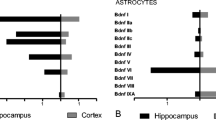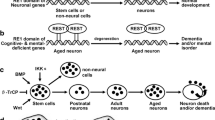Abstract
The synaptic glutamate level homeostasis is mainly maintained by the astrocytes membrane bound glutamate transporter type-1 (GLT-1/EAAT2). Alterations in its expression during development and aging and the underlying mechanisms are not well studied. Here, we report that NF-κB interaction was highest in both cerebral and cerebellar cortices at day 15 when compared with that at day 0 during development, and it further declined significantly in day 45, and remained unchanged in 20 and 70 weeks mice. On the other hand, N-myc interaction was highest at 0 day which significantly declined at 15-day and interestingly remained unaltered at later ages in both the cortices. This age dependent reciprocal pattern of NF-κB and N-myc interactions with their cognate GLT-1 promoter sequences was further correlated with GLT-1 protein and transcript levels. We found that higher NF-κB interaction with its cognate GLT-1 promoter sequences correlates with up-regulation whereas the higher N-myc interaction correlates with down-regulation of GLT-1 expression during postnatal developmental age up to 15 day, however, such phenomenon was not found in the higher ages from day 45 to 70 weeks. Thus our data suggests a postnatal development- and age dependent differential interaction of transcription factors NF-κB and N-myc to their respective sequences and they act as positive and negative regulator, respectively of GLT-1 gene expression in the brain during early developmental period in both cerebral and cerebellar cortices which might be different in aging of mice.




Similar content being viewed by others
References
Tanaka K (2000) Functions of glutamate transporters in the brain. Neurosci Res 37:15–19
Seal RP, Amara SG (1999) Excitatory amino acid transporters: a family in flux. Annu Rev Pharmacol Toxicol 39:431–456
Levy LM, Warr O, Attwell D (1998) Stoichiometry of the glial glutamate transporter GLT-1 expressed inducibly in a Chinese hamster ovary cell line selected for low endogenous Na1-dependent glutamate uptake. J Neurosci 19:9620–9628
Kataoka Y, Morii H, Watanabe Y, Ohmori H (1997) A postsynaptic excitatory amino acid transporter with chloride conductance functionally regulated by neuronal activity in cerebellar Purkinje cells. J Neurosci 17:7017–7024
Lehre KP, Danbolt NC (1998) The number of glutamate transporter subtype molecules at glutamatergic synapses: chemical and stereological quantification in young adult rat brain. J Neurosci 18:8751–8757
Haugeto O, Ullensvang K, Levy LM, Chaudhry FA, Honore T, Nielsen M, Lehre KP, Danbolt NC (1996) Brain glutamate transporter proteins form homomultimers. J Biol Chem 271:27715–27722
Marcaggi P, Attwell D (2004) Role of glial amino acid transporters in synaptic transmission and brain energetics. Glia 47:217–225
Lehre KP, Levy LM, Ottersen OP, Storm-Mathisen J, Danbolt NC (1995) Differential expression of two glial glutamate transporters in the rat brain: quantitative and immunocytochemical observations. J Neurosci 15:1835–1853
Milton ID, Banner SJ, Ince PG, Piggott NH, Fray AE, Thatcher N, Horne CH, Shaw PJ (1997) Expression of the glial glutamate transporter EAAT2 in the human CNS: an immunohistochemical study. Mol Brain Res 52:17–31
Robinson MB (2006) Acute regulation of sodium-dependent glutamate transporters: a focus on constitutive and regulated trafficking. Handb Exp Pharmacol 175:251–275
Rothstein JD, Martin L, Levey AI, Dykes-Hoberg M, Jin L, Wu D, Nash N, Kuncl RW (1994) Localization of neuronal and glial glutamate transporters. Neuron 13:713–725
Morrison JH, Baxter MG (2013) The aging cortical synapse: hallmarks and implications for cognitive decline. Nat Rev Neurosci 13(4):240–250
Tzingounis AV, Wadiche JI (2007) Glutamate transporters: confining runaway excitation by shaping synaptic transmission. Nat Rev Neurosci 8:935–947
Choi DW (1988) Glutamate neurotoxicity and diseases of the nervous system. Neuron 1:623–634
Furuta A, Rothstein JD, Martin LJ (1997) Glutamate transporter protein subtypes are expressed differentially during rat CNS development. J Neurosci 17:8363–8375
Thomas CG, Tian H, Diamond JS (2011) The relative roles of diffusion and uptake in clearing synaptically released glutamate change during early postnatal development. J Neurosci 31(12):4743–4754
Lee SG, Su ZZ, Emdad L, Gupta P, Sarkar D, Borjabad A, Volsky DJ, Fisher PB (2008) Mechanism of ceftriaxone induction of excitatory amino acid transporter-2 expression and glutamate uptake in primary human astrocytes. J Biol Chem 283:13116–13123
Sitcheran R, Gupta P, Fisher PB, Baldwin AS (2005) Positive and negative regulation of EAAT2 by NF-κB: a role for N-myc in TNFα-controlled repression. EMBO J 24:510–520
Kaltschmidt B, Widera D, Kaltschmidt C (2005) Signaling via NF-κB in the nervous system. Biochim Biophys Acta 1745:287–299
Blackwood EM, Eisenman RN (1991) Max: a helix-loop-helix zipper protein that forms a sequence-specific DNA-binding complex with Myc. Science 251(4998):1211–1217
Boersma MC, Dresselhaus EC, De Biase LM, Mihalas AB, Bergles DE, Meffert MK (2011) A requirement for NF-κB in developmental and plasticity-associated synaptogenesis. J Neurosci 31(14):5414–5425
Wey A, Knoepfler PS (2010) C-myc and N-myc in the developing brain. Aging 2(5):261–262
Verma P, Singh P, Gandhi BS (2013) Prophylactic efficacy of Bacopa monnieri on decabromodiphenyl ether (PBDE-209)-induced alterations in oxidative status and spatial memory in mice. Asian J Pharm Clin Res 6(3):242–247
Dignam JD, Lebovitz RM, Roeder RG (1983) Accurate transcription initiation by RNA polymerase II in a soluble extract from isolated mammalian nuclei. Nucleic Acids Res 11:1475–1489
Bradford MM (1976) Rapid and sensitive method for the quantitation of microgram quantities of protein utilizing the principle of protein-dye binding. Anal Biochem 72:248–254
Su ZZ, Leszczyniecka M, Kang DC, Sarkar D, Chao W, Volsky DJ, Fisher PB (2003) Insights into glutamate transport regulation in human astrocytes: cloning of the promoter for excitatory amino acid transporter 2 (EAAT2). Proc Natl Acad Sci USA 100:1955–1960
Prasad S, Singh K (2008) Interaction of USF1/USF2 and α-Pal/Nrf1 to Fmr-1 promoter increases in mouse brain during aging. Biochem Biophys Res Commun 376(2):347–351
Cauley K, Verma IM (1994) κB enhancer-binding complexes that do not contain NF-κB are developmentally regulated in mammalian brain. Proc Natl Acad Sci USA 91:390–394
Gupta RK, Kanungo M (2013) Glial molecular alterations with mouse brain development and aging: up-regulation of the Kir4.1 and aquaporin-4. Age (Dordr) 35:59–67
Gupta RK, Prasad S (2013) Early down regulation of the glial Kir4.1 and GLT-1 expression in pericontusional cortex of the old male mice subjected to traumatic brain injury. Biogerontology. doi:10.1007/s10522-013-9459/y
Danbolt NC (2001) Glutamate uptake. Prog Neurobiol 65:1–105
Rothstein JD, Dykes-Hoberg M, Pardo CA, Bristol LA, Jin L, Kuncl RW, Kanai Y, Hediger MA, Wang Y, Schielke JP, Welty DF (1996) Knockout of glutamate transporters reveals a major role for astroglial transport in excitotoxicity and clearance of glutamate. Neuron 16(3):675–686
Trotti D, Aoki M, Pasinelli P, Berger UV, Danbolt NC, Brown RHJ, Hediger MA (2001) Amyotrophic lateral sclerosis-linked glutamate transporter mutant has impaired glutamate clearance capacity. J Biol Chem 276:576–582
Li S, Mallory M, Alford M, Tanaka S, Masliah E (1997) Glutamate transporter alterations in Alzheimer disease are possibly associated with abnormal APP expression. J Neuropathol Exp Neurol 56:901–911
Tanaka K, Watase K, Manabe T, Yamada K, Watanabe M, Takahashi K, Iwama H, Nishikawa T, Ichihara N, Kikuchi T, Okuyama S, Kawashima N, Hori S, Takimoto M, Wada K (1997) Epilepsy and exacerbation of brain injury in mice lacking the glutamate transporter GLT-1. Science 276:1699–1702
Torp R, Lekieffre D, Levy LM, Haug FM, Danbolt NC, Meldrum BS, Ottersen OP (1995) Reduced postischemic expression of a glial glutamate transporter, GLT1, in the rat hippocampus. Exp Brain Res 103:51–58
Martin LJ, Brambrink AM, Lehmann C, Portera-Cailliau C, Koehler R, Rothstein J, Traystman RJ (1997) Hypoxia-ischemia causes abnormalities in glutamate transporters and death of astroglia and neurons in newborn striatum. Ann Neurol 42:335–348
Wang Z, Pekarskaya O, Bencheikh M, Chao W, Gelbard HA, Ghorpade A, Rothstein JD, Volsky DJ (2003) Reduced expression of glutamate transporter EAAT2 and impaired glutamate transport in human primary astrocytes exposed to HIV-1 or gp120. Virology 312:60–73
Chan H, Butterworth RF (1999) Evidence for an astrocytic glutamate transporter deficit in hepatic encephalopathy. Neurochem Res 24:1397–1401
Li Z, Sheng M (2003) Some assembly required: the development of neuronal synapses. Nat Rev Mol Cell Biol 4:833–841
Iino M, Goto K, Kakegawa W, Okado H, Sudo M, Ishiuchi S, Miwa A, Takayasu Y, Saito I, Tsuzuki K, Ozawa S (2001) Glia-synapse interaction through ca2+-permeable AMPA receptors in bergmann glia. Science 292:926–929
Oliet SH, Piet R, Poulain DA (2001) Control of glutamate clearance and synaptic efficacy by glial coverage of neurons. Science 292:923–926
Huang YH, Bergles DE (2004) Glutamate transporters bring competition to the synapse. Curr Opin Neurobiol 14:346–352
Bhakar AL, Tannis LL, Zeindler C, Russo MP, Jobin C, Park DS, MacPherson S, Barker PA (2002) Constitutive nuclear factor-κB activity is required for central neuron survival. J Neurosci 22:8466–8475
Simakajornboon N, Gozal E, Gozal D (2001) Developmental patterns of NF-κB activation during acute hypoxia in the caudal brainstem of the rat. Brain Res Dev Brain Res 127:175–183
Levy LM, Lehre KP, Walaas SI, Storm-Mathisen J, Danbolt NC (1995) Down-regulation of glial glutamate transporters after glutamatergic denervation in the rat brain. Eur J Neurosci 7:2036–2041
Hein C, Horvath E, Kugler P (2001) Glutamate transporter expression in astrocytes of the rat dentate gyrus following lesion of the entorhinal cortex. Eur J Neurosci 13:1839–1848
Poitry-Yamate CL, Vutskits L, Rauen T (2002) Neuronal-induced and glutamate-dependent activation of glial glutamate transporter function. J Neurochem 82:987–997
Knoepfler PS, Cheng PF, Eisenman RN (2002) N-myc is essential during neurogenesis for the rapid expansion of progenitor cell populations and the inhibition of neuronal differentiation. Genes Dev 16:2699–2712
Acknowledgments
R.K.G. thanks CSIR for Junior and Senior Research Fellowships (File No: 09/013 (0111) 2007-EMR I). Financial assistance from CSIR (37/1389/09/EMR-II) and BRNS (2009/37/55/3298), Govt. of India to SP is gratefully acknowledged.
Author information
Authors and Affiliations
Corresponding author
Additional information
Rajaneesh Kumar Gupta and S. Prasad dedicated the manuscript to Professor M. S. Kanungo, father of aging research in India, who died in July 2011.
Electronic supplementary material
Below is the link to the electronic supplementary material.
Rights and permissions
About this article
Cite this article
Gupta, R.K., Prasad, S. Differential Regulation of GLT-1/EAAT2 Gene Expression by NF-κB and N-myc in Male Mouse Brain During Postnatal Development. Neurochem Res 39, 150–160 (2014). https://doi.org/10.1007/s11064-013-1200-3
Received:
Revised:
Accepted:
Published:
Issue Date:
DOI: https://doi.org/10.1007/s11064-013-1200-3




